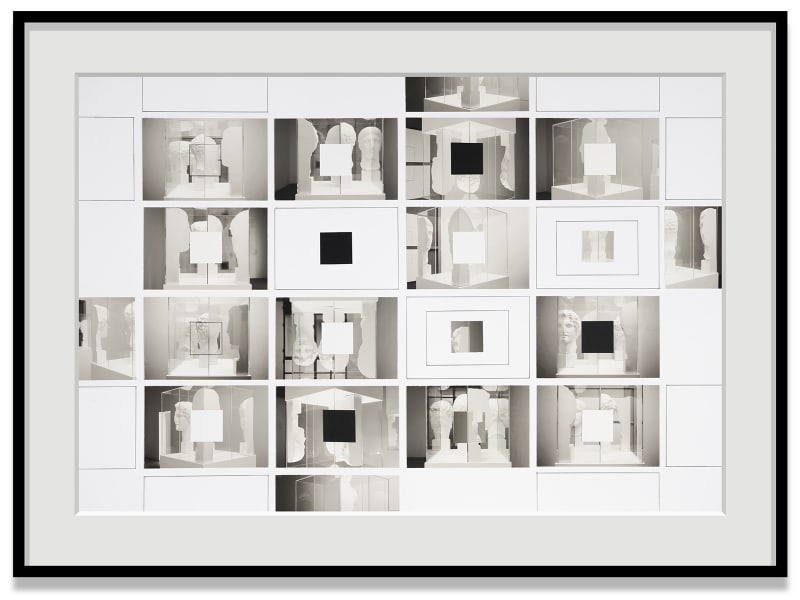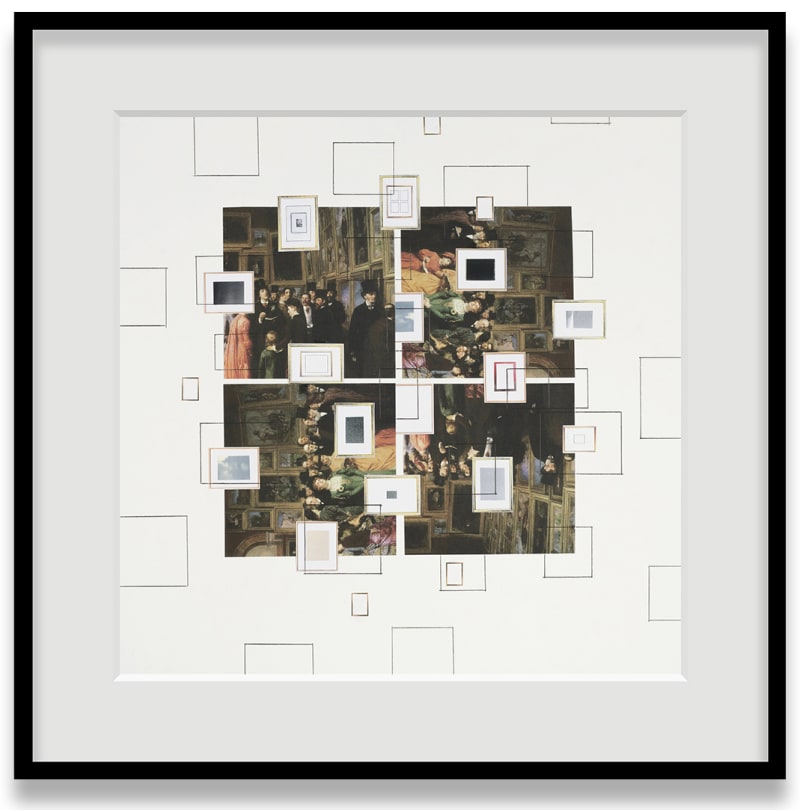Giulio Paolini Belvedere
Giulio Paolini (Genoa, Italy, 1940) began his career as an artist in 1960 in Turin. From his first solo show in 1964 to today he has held numerous exhibitions in international museums and galleries. Right from the start he has accompanied his practice with writings, gathered in volumes he personally edited.
His poetics revolve around themes that question the notion, manifestation, and vision of an artwork. Since his first explorations regarding elements that compose a painting, his attention shifted to display, to considering a work as a catalogue of its own possibilities, as well as to the figure of the artist and his lack of contact with the work, which exists before and moves beyond him.
A perspective room drawn directly onto the wall inscribes two trapezoidal canvases simulating two paintings suspended on the side walls of a virtual room. A third central canvas evokes a painting on the back wall. Within it, a pencil drawing mirrors the room’s layout, inhabited by two characters standing opposite each other, each looking at the picture in front of them. The large leaning stretcher frame, its canvas cloth wrapped around the top border with six mounted spotlights, acts as a “curtain” raised on the stage.
The title, inspired from a famous comedy by Luigi Pirandello (Six characters in search of an author, 1921), refers to the doubling of the figure of author and the painting, which, paradoxically, remain two unknowns. The 'authorless' painting -- evoked by both the recto/verso canvases and the curtain-frame-- remains precluded from our gaze, while the two stunt doubles replace the author who has left the stage.
"To whom is an artwork destined? To no one. Not, alas, to its author, who gives it to us, and in so doing is deprived of it; not to the spectator who believes and deceives himself into thinking that he is the recipient and that he can possess and evaluate it. An artwork cannot be truly given to anyone, and this is its true value and its splendor. Only in this way can we enjoy it disinterestedly, without expectations and without requiring any answers."
—Giulio Paolini
From Andrea Bellini, Giulio Paolini. A Normal Life, in “Flash Art” (International edition), 2007

"What will I love if not the enigma?" This phrase, the title of a self-portrait by de Chirico from 1911, is taken up by Paolini in 1969 and presented in the form of a large road banner, elevated to a political dogma with an improbable impact. In this collage, the phrase is brought back on a business card as "professional reason", following the artist's name.
"The enigma is inevitably accompanied by a sort of obsessive proceeding and renewed every time the artist faces a new passage, meaning, he moves on to the next artwork. After all, it is as if we were always in front of the first one, because it is not that the artist proceeds towards the truth. If we want, his truth is in not having wanted to accept it, and therefore here he is with the unsolvable presence of the enigma ... "
—Giulio Paolini

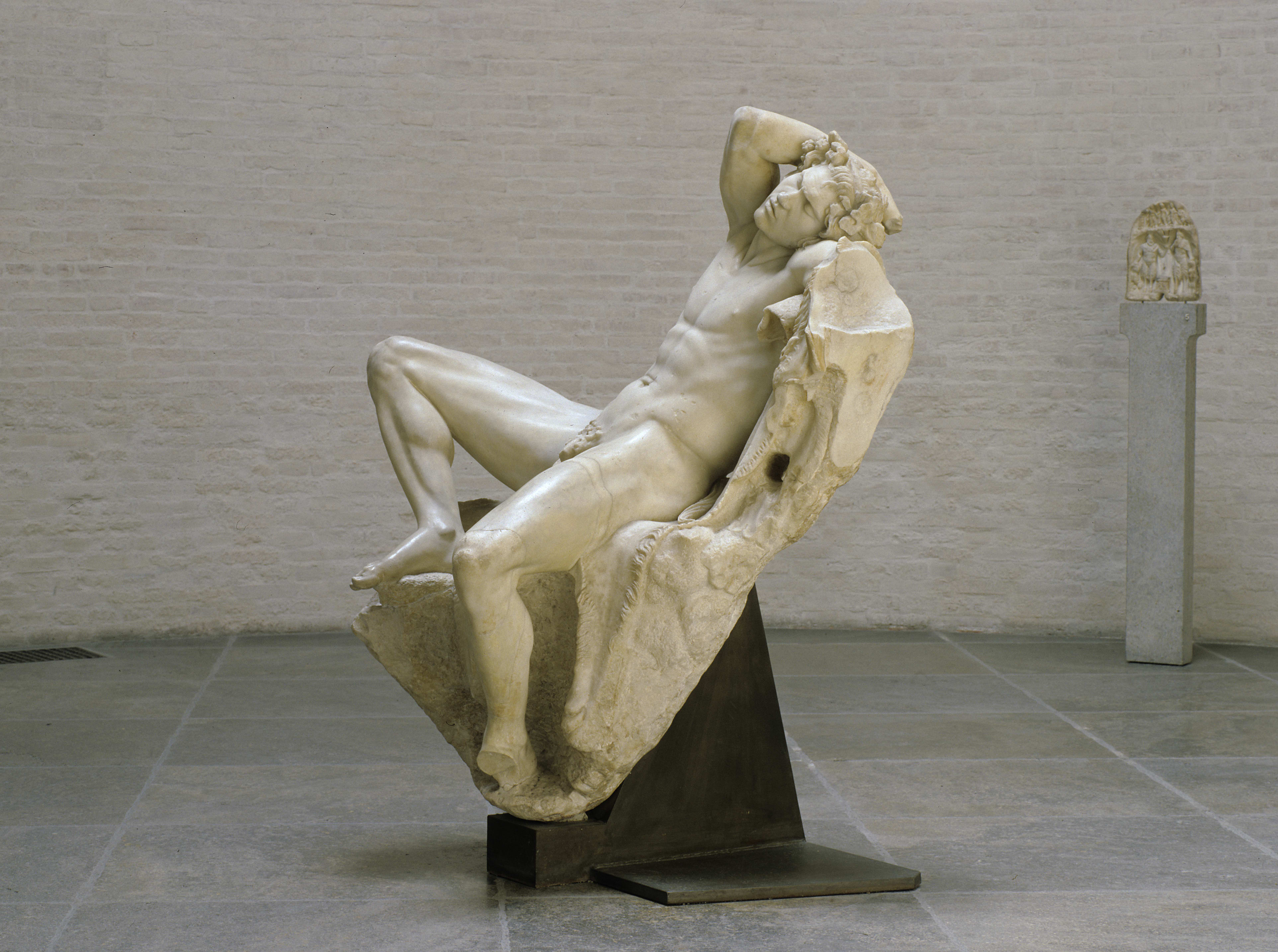
Barberini Faun, around 220 BC
State Collections of Antiquties and Glyptothek
Photograph by Renate Kühling
The two halves of the Barberini Faun are arranged opposite each other. "Interval" - writes the artist - "is the distance that separates the two 'moments' in which the figure deconstructs. But, on a closer look, there are two intervals: the first one, visible, constitutes the short distance that separates the two halves of the same statue between the two walls of the room; the second, virtual or imaginary, is our planet’s entire circumference (minus the short portion visible in the room) through which the two halves could come together."
"Art history is not a sequence of soloists (of single authors), but rather a system of voices in unison (history). It’s not a choir but a score for many voices in counterpoint. What I think is that the role of the artist, today and always, is not to take a place in the crowd in order to wait his/her turn to speak, but rather to stand apart, to not take part, to look for a point of equilibrium in the double role of author/spectator."
—Giulio Paolini
From Andrea Bellini, Giulio Paolini. A Normal Life, in “Flash Art” (International edition)
Against a sky-blue background, planets and celestial spheres stand out with the half-hidden Barberini Faun in the center. The classical statue seems intent on observing the swirling movement of the stars surrounding itself. Each of the elements gathered here are united by an infinite distance from our present, both physical and cultural. It is precisely in this dimension of remote universes, of unattainable beauty, which eludes any contact and realistic evidence, that the fascination of these images resides for the artist.

In Studio for "Mimesi" the two figures look at each other: the sculpture - and its profile traced in pencil - assume the symbolic, precise and absolute value of being the incarnation of the artwork.
"In each of the works entitled Mimesi, the work does not wait for our gaze, our appreciation, our comment, but it fixely contemplates itself, asking itself (and therefore asking its identical twin) the reason why it exists." —Giulio Paolini

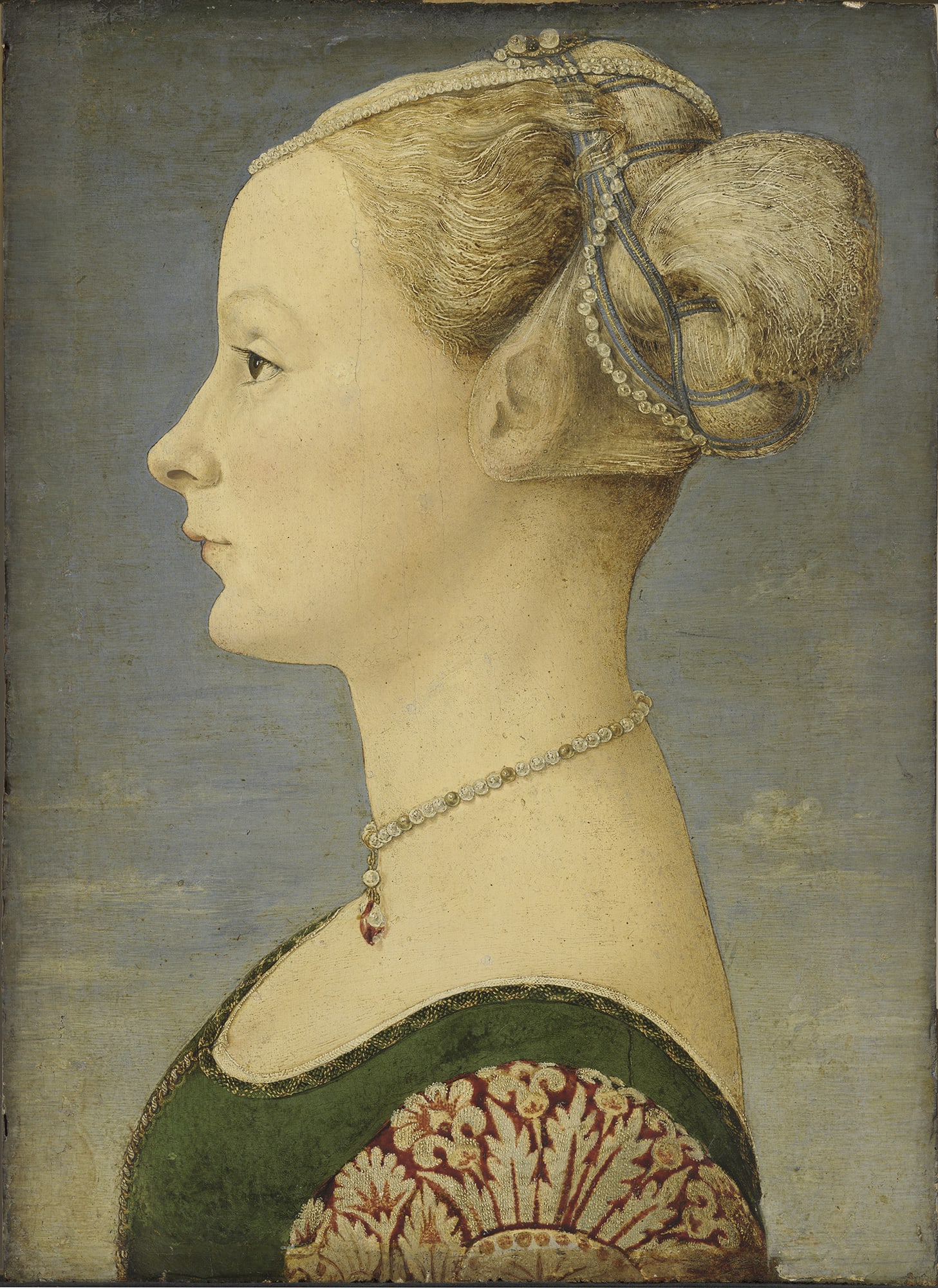
Piero del Pollaiolo, Portrait of young lady, 1470-1475
Tempera and oil on panel, 45,5 × 32,7 cm, inv. 442
© Museo Poldi Pezzoli, Milano – foto Malcangi
The silhouette of the young woman's face by Pollaiolo is inscribed in the image of an ancient sailing ship in navigation. Her profile, turned to the left, seems to steer the course towards an unknown destination.
"Through the laceration I break the regularity of the image or the margins of the white sheet, but I always try to draw a contour that either contrasts or follows in part that of the image or of the starting surface."
—Giulio Paolini

Frame: 26 x 26 x 1 5/8 in. (66 x 66 x 4.1 cm)
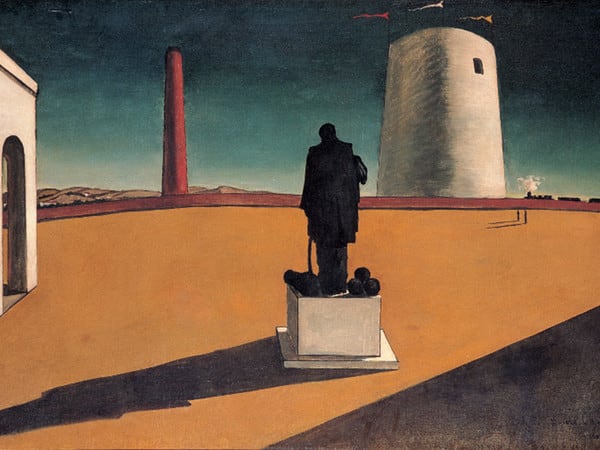
Giorgio de Chirico, O Enigma de um Dia, 1914
Oil on canvas, 83 cm x 130 cm
Courtesy: MAC USP Collection, Brazil
© 2020 Artists Rights Society (ARS), New York/ SIAE, Rome
Two different paintings by Giorgio de Chirico, one of the "Squares of Italy" and the "Enigma of a day" (1914) are evoked by Paolini in a single, composite image; in the background, ancient ruins hold the elements in the foreground in a timeless space, reminiscent of the metaphysical atmosphere of the well-known squares painted by de Chirico.
We would like to thank the Fondazione Giulio e Anna Paolini (Turin), Bettina Della Casa, Maddalena Disch, and the Fondazione Carriero (Milan).
Copyrights and Credits
Works by Giulio Paolini:
Nascita di Venere (The Birth Of Venus), 2016
© Giulio Paolini. Photo Rebecca Fanuele. Courtesy Fondazione Giulio e Anna Paolini, Turin
L'exil du cygne, 2019
© Giulio Paolini. Photo Luca Vianello. Courtesy Fondazione Giulio e Anna Paolini, Turin
Et quid amabo nisi quod ænigma est?, 1969-1970
© Giulio Paolini. Photo Adam Reich. Courtesy Fondazione Giulio e Anna Paolini, Turin
Intervallo (Interval), 1985
© Giulio Paolini. Photo Luca Vianello. Courtesy Fondazione Giulio e Anna Paolini, Turin
Senza titolo (Untitled), 1965
© Giulio Paolini. Photo Luca Vianello. Courtesy Fondazione Giulio e Anna Paolini, Turin
Senza titolo (Untitled), 1966
© Giulio Paolini. Photo Luca Vianello. Courtesy Fondazione Giulio e Anna Paolini, Turin
Belvedere (Look-Out), 1990
© Giulio Paolini. Photo Luca Vianello. Courtesy Fondazione Giulio e Anna Paolini, Turin
Belvedere (Look-Out), 1992
© Giulio Paolini. Photo Luca Vianello. Courtesy Fondazione Giulio e Anna Paolini, Turin
Studio per “Quadrante” (Study for “Quadrante”), 2002
© Giulio Paolini. Photo Luca Vianello. Courtesy Fondazione Giulio e Anna Paolini, Turin
Studio per “Mimesi” (Study for “Mimesi”), 1975
© Giulio Paolini. Photo Luca Vianello. Courtesy Fondazione Giulio e Anna Paolini, Turin
Senza titolo (Untitled), 2015
© Giulio Paolini. Photo Luca Vianello. Courtesy Fondazione Giulio e Anna Paolini, Turin
Senza titolo (Untitled), 2012
© Giulio Paolini. Photo Luca Vianello. Courtesy Fondazione Giulio e Anna Paolini, Turin
La caduta nel mondo, 2012
© Giulio Paolini. Photo Adam Reich. Courtesy Fondazione Giulio e Anna Paolini, Turin
Senza titolo (Untitled), 2017
© Giulio Paolini. Photo Luca Vianello. Courtesy Fondazione Giulio e Anna Paolini, Turin
Per Oscar Wilde (To Oscar Wilde), 2017
© Giulio Paolini. Photo Luca Vianello. Courtesy Fondazione Giulio e Anna Paolini, Turin
References:
Jean Siméon Chardin, Soap Bubbles, v. 1734 Oil on canvas 24 x 24 7/8 in. (61 x 63.2 cm)
Collection Metropolitan Museum of Art, New York
Giorgio de Chirico O Enigma de um Dia, 1914 Oil on canvas 83 cm x 130 cm
Courtesy: MAC USP Collection, Brazil
© 2020 Artists Rights Society (ARS), New York/ SIAE, Rome
Barberini Faun, around 220 BC State Collections of Antiquties and Glyptothek
Photograph by Renate Kühling.
René Magritte, The Telescope (La lunette d’approche), 1963 Oil on Canvas 69 5/16 x 45 ¼ in. (176.1 x 114.9 cm)
Photograph by Hickey-Robertson. The Menil Collection, Houston
Video Courtesy of Fondazione Carriero - Milan
Video production ARTBOX
3D Produzioni to Sky Arte











